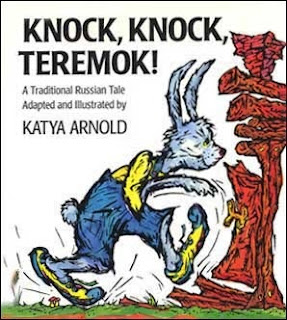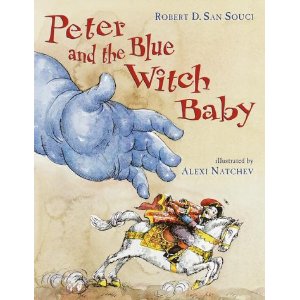
The base plot of this Ukrainian/ Russian folktale involves a shelter, numerous animals who hope to squeeze into it, and the inevitable breakdown of their temporary home. Sometimes this is a jar or a shack, but in Tresselt’s version, as you may guess, the shelter is a mitten. A little boy out gathering firewood on a snowy day drops his fur cuffed mitten, which is found by a delighted mouse. Soon, she is joined by larger and larger animals until a cricket proves to be more than the mitten can hold and its stitches pop open. The animals run away and the boy returns to find his mitten destroyed, but luckily his grandmother has made him a new pair.
In spite of the beauty of Jan Brett’s version, Tresselt’s The Mitten still has pleasant things to offer the reader, and so it’s nice to look at both versions. The story turns out to be the childhood memory of the narrator’s grandfather and the animals share the mitten out of concern for each other, which are pleasing details.
When judging the book’s art, you need to keep in mind that the book was produced in the mid 1960s, when full color pictures were used more modestly. Only a few ink colors are employed, but the results are attractive. Pages alternate between being entirely teal with black line drawings and white snowflakes or on white backgrounds with cheerful splashes of red, gold or green. The child and the animals are dressed in old fashioned Ukrainian costume. The pages preceding the story show the little mouse turning the book’s page and standing on the “M” in mitten.

In Brett’s story, the little boy, Nicki, wants his grandmother Baba to knit him snow white mittens. One is soon lost due to his outside play and before long it is filled with animals, beginning with a lucky mole. A little mouse on a bear’s nose brings about a sneeze that launches the now empty mitten into the air. Running by, Nicki catches the mitten and takes it home with its mate. One difference from Tresselt’s version is that the animals only let each other in because they are wary of talons, prickles and teeth!
I am certainly not the only one who thinks that Jan Brett’s book art is fantastic, and The Mitten is no exception. In the preface, Brett says that she visited the Ukrainian section of New York City and the Ukrainian Museum to learn more about their culture before she started drawing. All of the artwork is done in double page spreads, and the main picture is framed by birch bark with cutouts of the left and right mittens to either side. This allows the reader to see the current action, but also see what else is going on simultaneously. For example, as the hedgehog squeezes in with the rabbit and the mole, we can look at the left mitten and see Nicki looking into a knothole in a tree while an owl looks down at him, then look at the right mitten to see the owl leaving the tree as Nicki walks away. Where could the owl be headed? Every spread has changing embroidery motifs for added decoration. Brett gives us the folk flavor with her human characters’ costume, and details of their home inside and out. Her animals are realistic but expressive. Visual humor rounds out the book, when Nicki returns his newly unmatched mittens to his Baba.
Jan Brett has a wonderful website with coloring pages and other children's activities. Visit her at Jan Brett .
Knock, Knock Teremok!
Here we have a cumulative, rhyming story about a little hut (Teremok in Russian) and the many animals who want to live in it. It is a natural choice for storytime, because when we say “Knock, knock, knock. Who lives in the teremok?” each animal in turn announces itself. This leads to fun animal voices and noises. The party ends when a bear, unable to fit into the teremok, sits on the roof and squashes it flat.
Arnold notes that while this is a treasured animal story, she also sees it as “an allegory of the collapse of the Soviet Union and the socialist ideal of disparate peoples living peacefully together.” Arnold’s distinctive watercolor and black line art add to the pleasure of the book, from the appearance of the kerchief-wearing fly to the toppling of the mushroom-swagged teremok.



![Fool & The Flying Ship [VHS]](http://ws.amazon.com/widgets/q?MarketPlace=US&ServiceVersion=20070822&ID=AsinImage&WS=1&Format=_SL160_&ASIN=6304049536&tag=widgetsamazon-20)

















